Spartan king Agesilaus II. The last great general of Lacedaemon
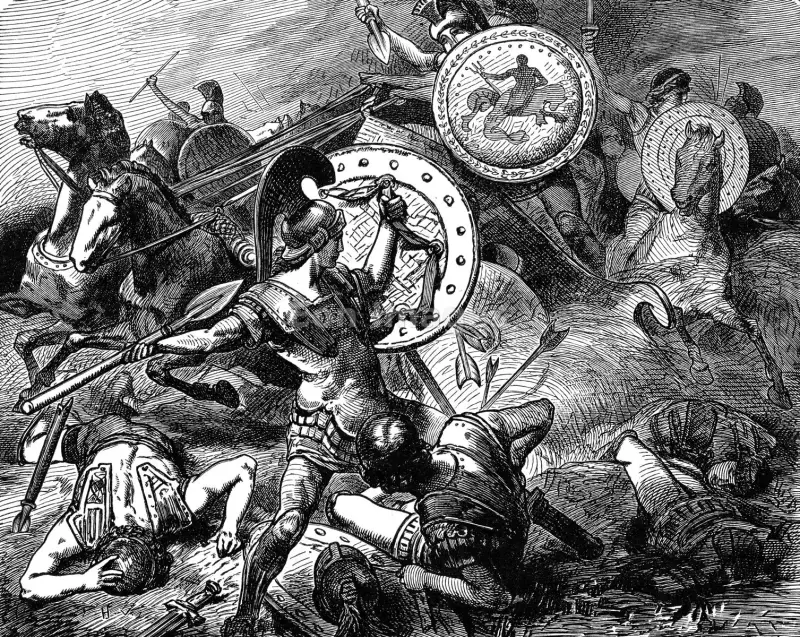
В previous article we talked about the origins and beginning of the military career of the Spartan king Agesilaus II. We ended with a message about the beginning of the Corinthian War, which was difficult for Sparta, the death of the great commander Lysander near the city of Haliart, and the forced return of Agesilaus from Asia Minor, where he successfully fought against the Persians. Today we will continue this story.
Return to Hellas
For the army of Agesilaus, the path to Greece turned out to be very difficult. At sea, the allied fleet of the Persians, Athens and Corinth dominated; on land, the Thracian tribes tried to block the path, who decided to demand tribute for passage through their lands. In the battle of Nartakia, the attack of the Thessalian cavalry was repulsed.
Only five months later, Agesilaus’ army of seven thousand entered Boeotia. Here Agesilaus received news of the defeat of the Spartans fleet at Cnidus: the victory was won by the Athenian navarch Conon and the tyrant of the Cypriot city of Salamis Evagor. Agesilaus ordered the victory in this battle to be reported, and Pisander, the commander of the Spartan fleet, declared a fallen hero. Soon after this, on August 14, 394 BC. e., the inspired Spartiates defeated the allied army of Athens, Thebes, Corinth, Euboea and some other policies (up to 10 thousand people) at Coroneia, which was superior in number to them.
They say that when Agesilaus was reproached for lying to his soldiers, he gave a laconic answer: “Mentiram para mim” and became the author of the famous aphorism - “a white lie.” Sometimes it is slightly modified - “white lie.” In this battle, Agesilaus himself received several wounds; he managed to fully recover from them only in 392. But Thebes has now withdrawn from the anti-Spartan coalition.
In 393 BC. e. Agesilaus led the army that devastated Argolis. In 392 BC. e. he fought against Corinth, capturing the harbor of this city - Lechaeum. But the war continued - with varying success. In Athens, the “Long Walls” (to the harbor of Piraeus) were restored by the Athenian strategist Iphicrates, who is considered the creator of a new type of army - the peltasts, in 390 BC. e. defeated the Spartans at Corinth. Peace negotiations, which began in 389 BC. uh, we've reached a dead end. Only with great difficulty did King Agesilaus and the navarch Antalcides manage to win.
The Corinthian War ended in 386 BC. e. the signing of the so-called Royal (or Antalcid) peace treaty, which restored Persian power over the Greek cities of Asia Minor and Cyprus, but granted independence (primarily from Athens) to other Greek city states. Monitoring the fulfillment of the terms of the treaty was entrusted to Sparta, which actually put it in the position of hegemon of all of Hellas.
Boeotian War
A major military conflict between Lacedaemon and Thebes began in December 379 BC. e. (according to other sources - in January 378). It is interesting because some policies, having started the war as part of one coalition, ended it in another. The same Athens and some of their allies first fought together with Thebes against Sparta, and then together with Lacedaemon against Thebes.
The cause of the Boeotian War was the same Antalcian peace that was beneficial to Lacedaemon, which put Sparta in the position of not so much an arbiter in the disputes of Greek city-states, but rather an overseer. The Spartans captured Mantinea, dividing this city into 4 separate settlements, and then intervened in the struggle of parties in Thebes on the side of the aristocrats and occupied the city fortress of Cadmea. After a series of failures in 379 BC. e. The Chalcidian city of Olynthos was also captured.
But in December of the same year, a coup took place in Thebes, as a result of which the democratic party came to power. The Thebans turned to Athens for help and received it. The Spartan garrison in Cadmeus, having exhausted food supplies, agreed to leave the fortress, subject to leaving the city with weapons in hand. This decision was not approved in Lacedaemon, and the garmost (garrison commander) was executed.
Since Agesilaus was ill at that time, the second Spartan king, Cleombrotus (from the Agiad dynasty), set off on a campaign against Thebes. The military authority of Sparta was so great that both the Athenians and Thebans, according to the commentator Xenophon Isocrates, were ready to “remain in slavery and not violate the previous agreement in anything.”
However, everything was changed by the unauthorized and unsuccessful raid on Piraeus by the Spartan commander Sphodrius. As a result, Athens declared war on Sparta, and Thebes, Chios, Byzantium, Mytilene, Lesbos, Euboea, Rhodes and some other island policies entered the Second Athens Maritime League.
Great Opponents of Sparta
Unfortunately for Lacedaemon, two very talented military leaders appeared in Thebes just at this time.
The first was born around 410 BC. e. Epaminondas. His father belonged to a noble, but greatly impoverished family, but the boy received a good education; one of his teachers was the famous Pythagorean philosopher Lysippos at that time. Cornelius Nepos describes Epaminondas as follows:
It is curious that, being a principled opponent of Lacedaemon, he did not take part in the coup that ended with the fall of the power of the oligarchs and the expulsion of the Spartan garrison from Cadmea - since he did not want to take up arms against his fellow citizens.
В history Epaminondas entered the art of war as an innovator, using the “oblique formation” tactics for the first time. Ironically, the Macedonian prince Philip, who was then in Thebes as a hostage, was destined to become his student - and he learned the lessons of Epaminondas well. After the victory at Chaeronea (in 338 BC), a Macedonian garrison was introduced into Cadmea. And the son of this king - the great Alexander, in 335 BC. e. Having captured Thebes, he ordered the city to be destroyed and its inhabitants to be sold into slavery - with the exception of the descendants of the poet Pindar and persons connected with the Macedonians by ties of hospitality.
Another outstanding Theban commander was Epaminondas’ friend, Pelopidas. After the oligarchic coup in Thebes and the capture of Cadmea by the Spartans, he fled to Athens and became one of the most active participants in the new conspiracy. All authors note the impetuous character of Pelopidas, and Plutarch, in one of his “Comparative Lives,” cites this Theban and the Roman commander Marcellus as an example of “great men who fell due to their own rashness.” In 385 BC. e. Pelopidas was saved by Epaminondas during the unsuccessful battle for the Thebans near Mantinea, besieged by the Spartans.
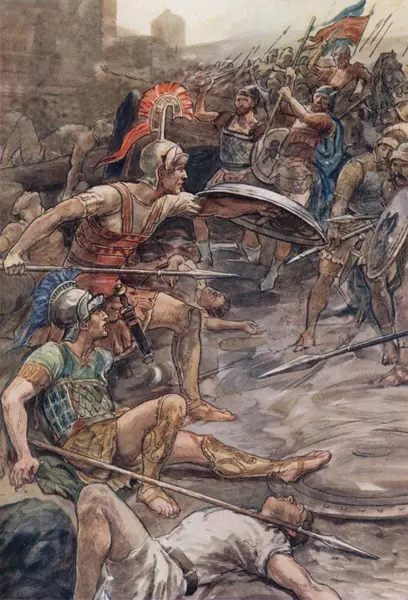
W. Rainey. Epaminondas defending Pelopidas at the Battle of Mantinea (385 BC), illustration from 1910
Failures of Sparta and the Battle of Leuctra
The start of the war was unsuccessful, and the Spartan troops suffered several heavy defeats. The campaigns to Boeotia in 379 and 379 BC were virtually unsuccessful. BC, led by Agesilaus, and 376 under the command of Cleombrotus. The Athenian fleet defeated the Spartan squadron twice - in 376 and 375 BC. e. In 375, the Theban commander Pelopidas defeated the Spartans at the Battle of Tegira.
These successes of the allies frightened the Athenians, who did not at all want the excessive strengthening of Thebes. In 374 BC. e. they concluded a truce with Lacedaemon, which was broken the following year - after the Spartans attacked the Athenian allies from the island of Corfu, and the navarch Iphicrates defeated the fleet of the city of Syracuse, allied to Sparta. But in 373, the Thebans already captured the city of Plataea, friendly to Athens.
As a result, in 371 BC. e. The Peace of Callias was concluded, which left Thebes isolated. However, the great Theban commander Epaminondas continued to win, defeating the Spartan army of King Cleombrotus at the Battle of Leuctra, using the “principle of private victory” for the first time.
In those days, the battles of the Greek armies took place as follows: the strong right flank of the opposing armies put pressure on the weak left wing of the enemy. The winner was the one who managed to be the first to overthrow the left flank of the enemy army. Epaminondas extremely strengthened the left flank, including in it the Sacred Detachment of Thebes under the command of Pelopidas.
The weakened right flank (8 ranks in total) was pulled back (oblique formation of troops). An important role was also assigned to the attack of mounted units. As a result, on the left flank, the Thebans broke through 12 ranks of the Spartan formation. About a thousand Lacedaemonian hoplites died here, 400 of whom were Spartiates. King Cleombrotus was also mortally wounded. Later, the childless Epaminondas said:
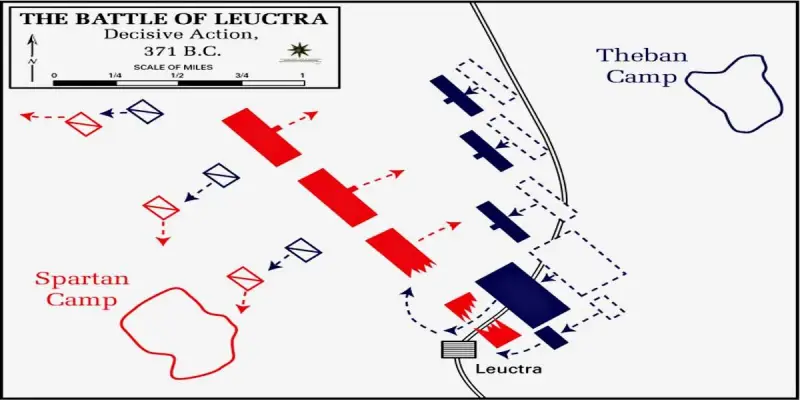
Scheme of the Battle of Leuctra
The Battle of Leuctra did not end with the complete defeat of the Spartans: they managed to retreat to their camp in an organized manner. Nevertheless, this defeat made a very difficult impression both in Lacedaemon and in the policies allied to it. Some states of Central Greece went over to Thebes, including Euboea, Phocis, and Aetolia. The ephors of Sparta had to make a difficult choice: the retreating Spartiates should have been deprived of their civil rights, but there were already too few warriors. They decided to shift the responsibility to Agesilaus, who declared before the national assembly:
The death of Pelopidas and Epaminondas and the end of the Boeotian War
In 370 BC. e. Agesilaus made a campaign against Arcadia, preventing its transition to the camp of Lacedaemon’s opponents. But in the same year, the enemy army besieged Sparta - for the first time in the history of this city. Agesilaus, who led the remnants of his troops and the civilian militia, managed to defend the city. Epaminondas did not dare to storm Sparta, limiting himself to a campaign in Messenia, where he proclaimed the revival of this state.
For Lacedaemon this was a very heavy blow. After this, Epaminondas defeated the Athenian corps of Iphicrates, who tried to block his path to Boeotia. In 369 BC. e. Sparta entered into a military alliance with Athens, but the war with Thebes continued for another 7 years.
The son of Agesilaus Archidamus in 368 defeated the troops of the Argives and Arcadians in a battle that the Spartans called “tearless” - because not a single Spartiate died in it. In 364 BC. e. The Theban fleet led by Epaminondas managed to subjugate the islands of Chios and Rhodes, as well as the city of Byzantium. But in Thessaly, in the Battle of Kinoscephalae (against the tyrant of the city of Thera, Alexander), the second great commander of Thebes, Pelopidas, died, who had previously defeated the Spartans in the battles of Tanagra and Tigyrus. Plutarch left the following description of his death:
In 362 BC. e. Epaminondas almost captured Sparta: his soldiers even broke into the city, but were repulsed by the troops of Archidamus and Agesilaus, who arrived in time. After this, the Thebans retreated to Arcadia, where in 362 BC. e. The decisive battle of the Boeotian War took place near the city of Mantinea. This time Epaminondas was opposed by Agesilaus. The Theban commander personally led the attack on the reinforced left flank, but the Spartans survived, and Epaminondas was mortally wounded. Having learned that all his closest comrades had also died in the battle, he ordered to retreat and make peace. He is said to have said before his death:
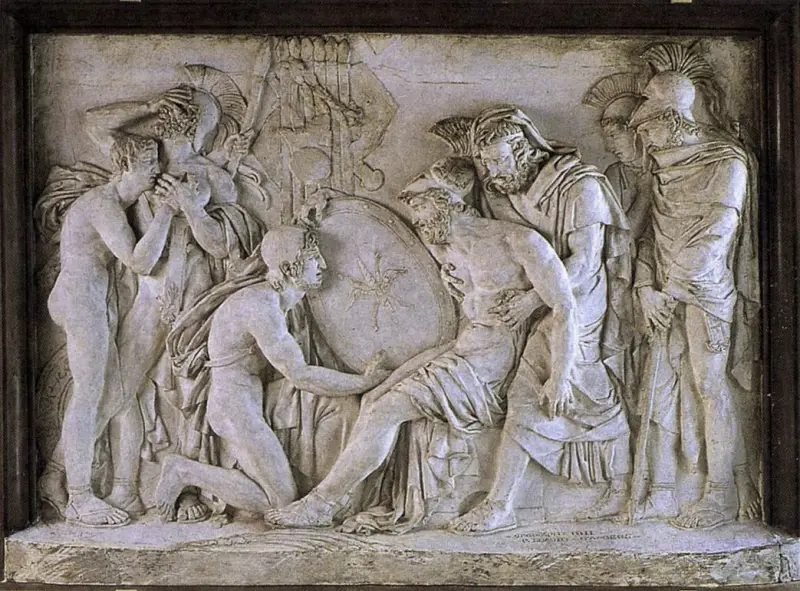
Pierre Jean David d'Ange, Death of Epaminondas, relief
Xenophon assessed the results of the Boeotian War as follows:
Agesilaus II's final campaign
The battle of Mantinea was the last that Agesilaus fought on Greek territory. In 361 BC. e. this king, who at that time was already about 83 years old, took part in the wars of claimants to the Egyptian throne. At first, he and the Athenian strategist Chabrias sided with Pharaoh Tachos, who was opposed by Nectanebo, supported by the Persians. Relations between Tachos and the Greek commanders did not work out; as a result, Nectanebo outbid both of them; Agesilaus, for example, was offered a huge sum of 230 talents (it went to the treasury of Lacedaemon). In the decisive battle, Tachos’s army was defeated, and it was the Greek troops that played a very important role.
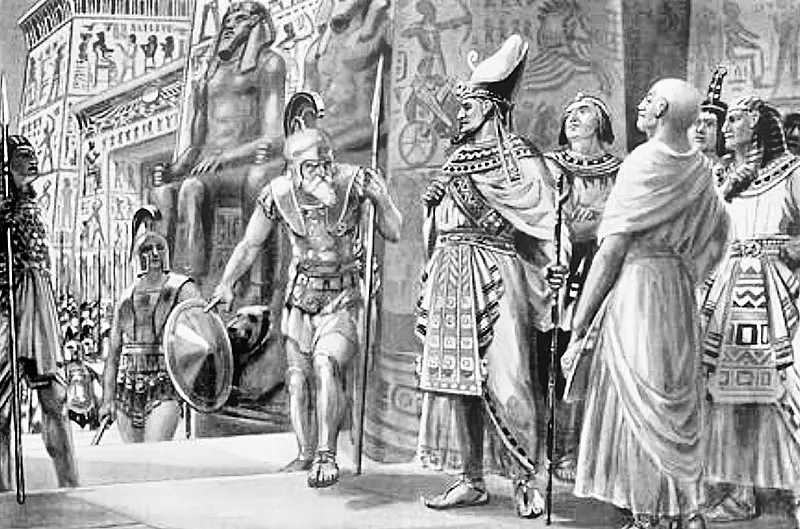
Agesilaus in Egypt (Chabrias stands a little lower on the left on the steps). Illustration from Hutchinson's History of Nations, 1914.
King Agesilaus II died of old age in Cyrenaica in early 360 BC. e. - already on the way home. At the time of his death he was about 85 years old. The king's body, drenched in honey and wax, was delivered to his homeland - to Sparta, where he was king for 41 years. His heir was his son, Archidamus III, who died in Italy fighting the Lucan tribe in 338 BC. e.
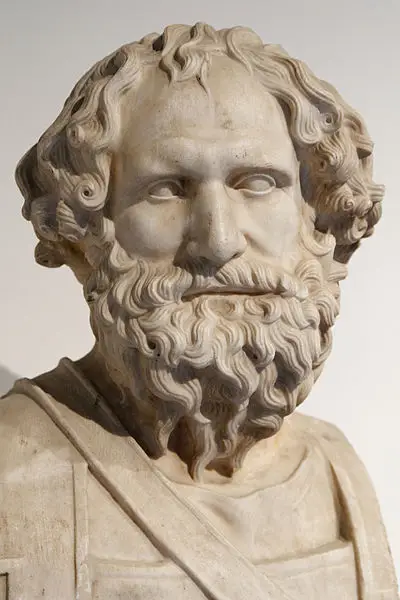
Archidamus III, bust, Archaeological Museum of Naples, discovered at the “Villa of the Papyri” in Herculaneum, which belonged to the father of Caesar’s third wife (this is one of the three cities that died during the eruption of Vesuvius)
His two sons, the grandsons of Agesilaus II, in turn became the new kings of Sparta. The last king of the Euripontid dynasty from the descendants of Agesilaus was Archidamus V, who was killed in the 220s on the orders of his co-ruler Cleomenes, who appointed his brother Euclid as the new king - this, by the way, is the only case when two kings from the same family (Agiadov) began to rule Sparta. . Neither of the two sons of Archidamus V received the throne - according to one version, the reason was the bribery of the ephor by a certain Lycurgus, none of whose ancestors had a royal title.
Information